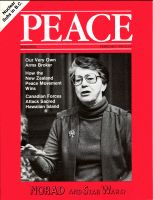
Peace Magazine Feb-Mar 1986, page 5. Some rights reserved.
Search for other articles by Phil Esmonde here
FLYING INTO HONOLULU, THE pilot comes over the P.A. system and points out the landmarks of Diamond Head and Waikiki. However, I am aware of what he doesn't mention: The airport runway is about two miles from a nuclear weapons storage area, and the approach to the runway passes within one mile of the 48 nuclear weapons storage bunkers at West Loch, by Pearl Harbor.
In fact, the Honolulu International Airport has been given a "red star" rating by the International Federation of Airline Pilots. Such a rating means that it is a question of when, not if, a major air disaster will occur. Within five miles of the airport are two other airports and military, commercial, and private planes are everywhere.
Oahu, the island where Honolulu is located, has one-quarter of its land area controlled by the military. The middle of Diamond Head is the camp for the National Guard. Hawaii is one of the most militarized places on earth. In 1972 there were 3100 nuclear weapons stored on Oahu alone, and according to the Stockholm International Peace Research Institute, there are 110 military installations here.
The military's presence is a point of pain for many, and especially the Hawaiians who were moved off their land only to see it being used for destructive purposes. Nothing hurts native Hawaiians more than the use of an island, Kaho'olawe, as a target for shore shelling, bombing, and practice landing attacks.
The island, eight miles off the coast of Maui, was taken over by the U.S. Navy after the Japanese attack at Pearl Harbor. It was subsequently signed over to the military for ongoing use through a Presidential decree in the early 1950s. Now it is constantly shelled and also is the site for practice shore shelling by foreign forces during the biennial RIMPAC (Rim of the Pacific) military exercises. These maneuvers include the navies of Australia, Japan, New Zealand, Canada, and the United States. The joint exercises end in the shelling of Kaho'olawe.
So unique is Kaho'olawe that the whole island is on the U.S. Registry of Historic Places. Rich in archaeologicalsites, it is one of the few remaining links to old Hawaiian culture.
Kaho'olawe is also unique in that the Hawaiian Senate and Congress passed resolutions in 1982 and 1984 asking that foreign governments not shell this island, which is sacred to the Hawaiian people. In 1982 our navy went ahead and shelled Kaho'olawe despite the resolutions. And in 1984 the Canadian Navy again shelled the island during RIMPAC exercises, having the dubious distinction of being the only foreign power to do so.
The people of Hawaii want Kaho'olawe returned to Hawaii. Through an organization called Protect Kaho'olawe Ohana (PKO), a grass-roots network throughout the Hawaiian Islands, efforts have been made to pressure the navy and foreign governments to stop the desecration of sacred temples, petroglyphs, and adze quarries. Through the efforts of PKO, the navy was forced to undertake an archaeological survey and at least 544 significant sites were located. The PKO negotiated some access to the island, and it has become one important part of a current revival of Hawaiian culture. A traditional Hawaiian house (a hale ) has been built on the island and limited tours are organized. The PKO has found damage from the shelling and insists that the island not be used any longer for such practice.
For Hawaiians, the concept of Aloha 'Aina is very real. It means having love for the land: giving in return to what gives one life. While to the military Kaho'olawe represents an uninhabited, rocky target, to Hawaiians it is a sacred place.
The PKO is preparing for the next round of RIMPAC exercises, feeling that if they can concentrate first on getting foreign governments to stop shelling, then they can be more effective with their own.
While I am here, word is received that the 1986 exercises will start on May 18 and last 45 days. For the first time, RIMPAC will include the British Navy, which will sail eight warships through the Panama Canal to join in what was up to now a purely Pacific exercise. It is thought that Britain has been invited by the United States as a slap at the Lange government of New Zeaand, who probably won't be invited to participate. It is also thought that British involvement is partially to show worldwide alliance from the Atlantic to the Pacific, and to affirm control of the waves.
There is no information as to whether Canada will participate in RIMPAC '86 or whether, if she does participate, she will shell the sacred Hawaiian island of Kaho'olawe. Given Canada's total disregard in 1982 and 1984 toward the Hawaiian people and their elected representatives, however, it is likely that our navy will continue doing so.
The PKO is asking for help in stopping Canadian use of the island during both RIMPAC exercises and non-RIMPAC shellings. They are asking that people write to their Members of Parliament and to their newspapers. They are also asking for help in getting information out to Canadians concerning our shelling of Hawaii. Those who can help or who want further information can contact the South Pacific Peoples Foundation, 407-620 View Street, Victoria, B.C. V8W 1J6.

Peace Magazine Feb-Mar 1986, page 5. Some rights reserved.
Search for other articles by Phil Esmonde here